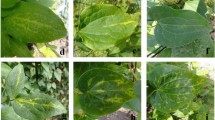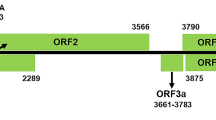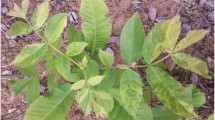Abstract
Common reed (Phragmites australis) plants showing chlorotic stripe symptoms on leaves were found in Gansu Province, China. Deep sequencing of small RNAs from symptomatic leaves identified a putative potyvirus, which was named common reed chlorotic stripe virus (CRCSV). The full genome sequence was determined by reverse transcription PCR, rapid amplification of cDNA ends (RACE) PCR, and sequencing. It consists of 9,426 nucleotides, excluding the poly(A) tail, and contains a large open reading frame encoding a polyprotein of 3,014 amino acids. Putative proteolytic cleavage sites were identified. Since CRCSV shared low sequence similarity (35%-37% identity) to any known members of the family Potyviridae and it clustered uniquely in phylogenetic analysis of either the polyprotein or the coat protein, CRCSV is a distinct, previously undescribed member of the family Potyviridae.

Similar content being viewed by others
References
Adams MJ, Antoniw JF, Fauquet CM (2005) Molecular criteria for genus and species discrimination within the family Potyviridae. Arch Virol 150:459–479
Adams MJ, Antoniw JF, Beaudoin F (2005) Overview and analysis of the polyprotein cleavage sites in the family Potyviridae. Mol Plant Pathol 6:471–487
Atreya CD, Raccah B, Pirone TP (1990) A point mutation in the coat protein abolishes aphid transmissibility of a potyvirus. Virology 178:161–165
Chung BY, Miller WA, Atkins JF, Firth AE (2008) An overlapping essential gene in the Potyviridae. Proc Natl Acad Sci USA 105:5897–5902
Deng CL, Wang WJ, Wang ZY, Jiang X, Cao YY, Zhou T, Fan ZF (2008) The genomic sequence and biological properties of Pennisetum mosaic virus, a novel monocot-infecting potyvirus. Arch Virol 153:921–927
Gal-On A (2000) A point mutation in the FRNK motif of the potyvirus helper component-protease gene alters symptom expression in cucurbits and elicits protection against the severe homologous virus. Phytopathology 90:467–473
Ilbağı H (2006) Common reed (Phragmites communis) is a natural host of important cereal viruses in the Trakya region of Turkey. Phytoparasitica 34:441–448
Ivanov KI, Eskelin K, Lõhmus A, Mäkinen K (2014) Molecular and cellular mechanisms underlying potyvirus infection. J Gen Virol 95:1415–1429
King AMQ, Lefkowitz E, Adams MJ, Castens EB (eds) (2012) Virus taxonomy: ninth report of the international committee on taxonomy of viruses, vol 9. Academic Press, London
Mal TK, Narine L (2004) The biology of Canadian weeds. 129. Phragmites australis (Cav.) Trin. ex Steud. Can J Plant Sci 84:365–396
Revers F, Le Gall O, Candresse T, Maule AJ (1999) New advances in understanding the molecular biology of plant/potyvirus interactions. Mol Plant Microbe Interact 12:367–376
Schröder P, Daubner D, Maier H, Neustifter J, Debus R (2008) Phytoremediation of organic xenobiotics–Glutathione dependent detoxification in Phragmites plants from European treatment sites. Bioresource Technol 99:7183–7191
Tamura K, Peterson D, Peterson N, Stecher G, Nei M, Kumar S (2011) MEGA5: molecular evolutionary genetics analysis using maximum likelihood, evolutionary distance, and maximum parsimony methods. Mol Biol Evol 28:2731–2739
Untiveros M, Olspert A, Artola K, Firth AE, Kreuze JF, Valkonen J (2016) A novel sweet potato potyvirus open reading frame (ORF) is expressed via polymerase slippage and suppresses RNA silencing. Mol Plant Pathol 17:1111–1123
Urcuqui-Inchima S, Haenni AL, Bernardi F (2001) Potyvirus proteins: a wealth of functions. Virus Res 74:157–175
Author information
Authors and Affiliations
Corresponding author
Ethics declarations
Funding
This work was supported by the Program for Changjiang Scholars and Innovative Research Team in University (Grant No. IRT1042).
Conflict of interest
The authors declare that they have no conflict of interest.
Ethical standards
This study did not include experiments with human participants or animals performed by any of the authors.
Electronic supplementary material
Below is the link to the electronic supplementary material.
Rights and permissions
About this article
Cite this article
Yuan, W., Du, K., Fan, Z. et al. Complete genomic sequence of common reed chlorotic stripe virus, a novel member of the family Potyviridae . Arch Virol 162, 3541–3544 (2017). https://doi.org/10.1007/s00705-017-3454-6
Received:
Accepted:
Published:
Issue Date:
DOI: https://doi.org/10.1007/s00705-017-3454-6




